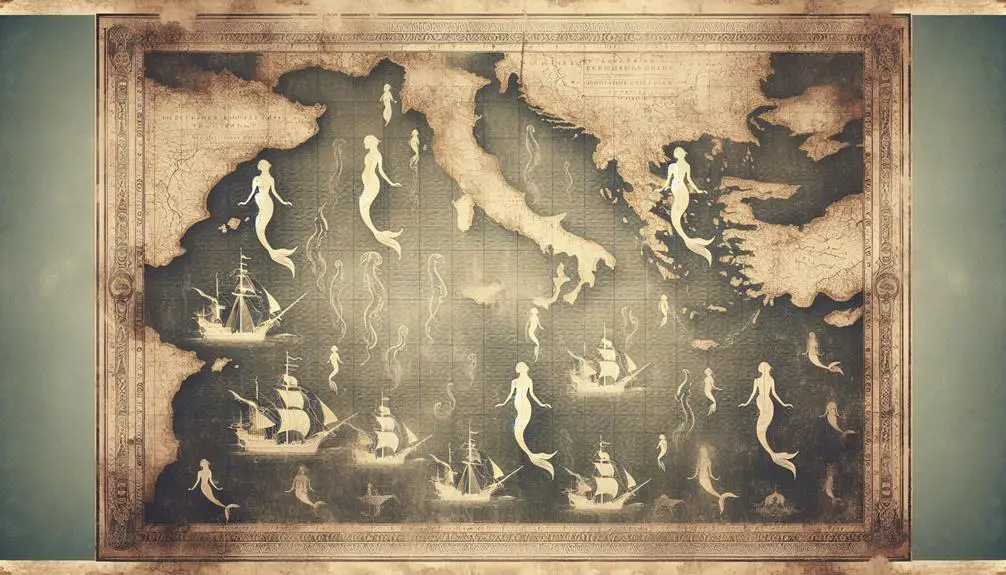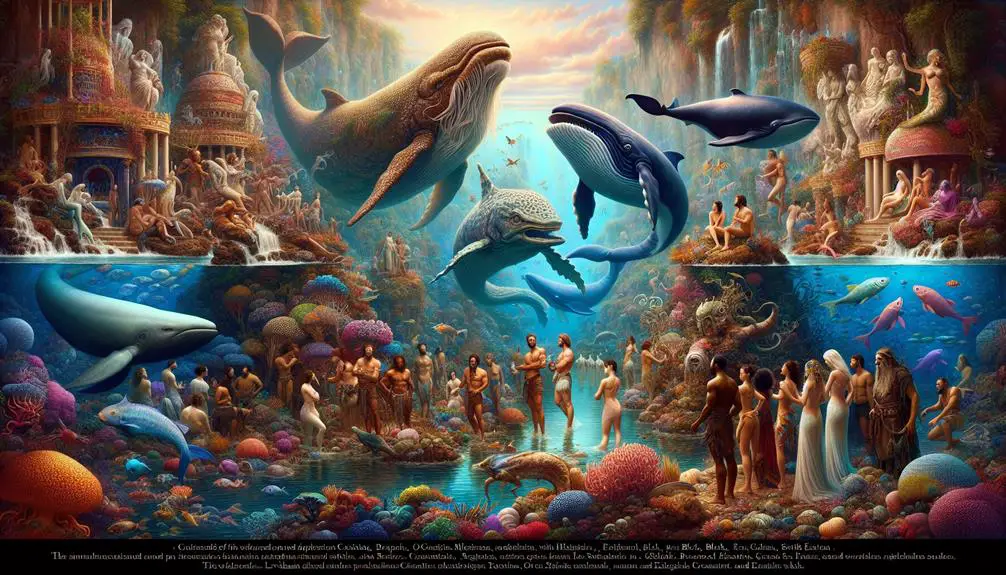Investigate the intriguing possibility of mermaids in biblical texts and explore what scholars say about these mythical beings' place in scripture.

Are Mermaids in the Bible
You've heard about angels in the heavens and giants on the earth, but have you ever wondered if mermaids swim through the pages of the Bible?
This question takes us into a fascinating exploration of historical beliefs, biblical texts, and the symbolism used by ancient cultures.
While the Bible is rich with metaphor and parable, the existence of mermaids within its verses is an intriguing topic that bridges the gap between myth and scripture.
By examining the texts and considering scholars' perspectives, you're on the cusp of uncovering whether these mythical beings hold a place in biblical lore.
Key Takeaways
- The Bible does not explicitly mention mermaids or depict them in its texts.
- Biblical references to sea creatures like Leviathan symbolize chaos, not mermaids.
- Misinterpretations of symbolic language can lead to the mistaken belief in biblical mermaids.
- Understanding the symbolic and metaphorical use of creatures in the Bible is crucial to accurate interpretation.
Historical Context of Mermaids

Throughout history, mermaids have captivated human imagination, appearing in various cultures' myths and folklore as symbols of both beauty and peril. These mythical creatures, often depicted as half-human, half-fish, resonate deeply within maritime folklore, highlighting humanity's complex relationship with the sea—a source of sustenance, mystery, and danger.
You'll find that mermaids' cultural influence stretches far and wide, serving various symbolic roles across different societies. In some narratives, they're seen as benevolent beings, guiding lost sailors to safety or bestowing good fortune. In others, they represent the capricious nature of the sea, luring men to their doom with their enchanting songs and beauty. This duality reflects the unpredictable nature of the oceans, which can be both life-giving and mercilessly destructive.
Mermaids also embody the human fascination with the unknown. As explorers ventured into uncharted waters, tales of mermaids underscored the mysteries that lay beyond the map's edge. They became metaphors for the unexplored and the undiscovered, mirroring the allure and the fear of the vast, unmastered oceans.
The enduring appeal of mermaids in popular culture can be attributed to their ability to navigate between worlds—human and aquatic, reality and myth. Their presence in folklore underscores the power of storytelling in making sense of the natural world, providing a bridge between the known and the unknown.
As symbols of both beauty and peril, mermaids continue to captivate, embodying the human quest for knowledge and the age-old fascination with the mysteries that lie beneath the waves. Their tales, rich in maritime folklore and cultural influence, remind us of the deep connections humans have always had with the sea.
Biblical Texts Examined

While mermaids have predominantly occupied the realm of folklore and myth, examining references to similar entities in biblical texts offers a unique lens through which to explore their conceptual origins and cultural significance. The Bible doesn't explicitly mention mermaids, but it's replete with aquatic metaphors and divine representations that echo the mystique surrounding these legendary beings. Through a scholarly analysis, one can uncover layers of meaning that resonate with the mermaid's symbolism in various cultures.
Reference |
Interpretation |
|---|---|
Leviathan (Job 41, Psalms 74:14, Isaiah 27:1) |
Often depicted as a monstrous sea creature, Leviathan's presence in the Bible could be seen as a precursor to the mermaid myth. While not a direct correlation, the imagery of powerful beings dwelling in the depths plays into the mystique of mermaids. |
"Living creatures" (Ezekiel 1:5-10) |
Ezekiel's vision includes beings with multiple faces, one of which is that of a man. Though not aquatic in nature, this juxtaposition of human and animal characteristics parallels mermaid mythology. |
"Sea of glass" (Revelation 4:6) |
While not a creature, the imagery of a crystal-clear sea before God's throne invokes a sense of divine mystery and beauty akin to the allure of mermaids. |
These texts, while not directly referencing mermaids, employ aquatic metaphors and divine representations that contribute to the broader tapestry of mythological creatures. They offer a window into understanding how cultures have historically intertwined human characteristics with the mysteries of the sea, fostering a fertile ground for the emergence of mermaid legends.
Common Misinterpretations

In the realm of biblical analysis, it's essential not to conflate metaphorical descriptions with literal interpretations, a common misstep when examining aquatic figures and their relation to mermaid myths. This error often stems from a limited understanding of the cultural origins and linguistic nuances present in ancient texts. When you delve into the original languages of the Bible—Hebrew, Aramaic, and Greek—a rich tapestry of meanings unfolds, demanding careful linguistic analysis to avoid misinterpretations.
Cultural origins play a pivotal role in understanding biblical references that might seem to allude to mermaids or similar entities. The societies that produced the biblical texts were steeped in symbolism and often used the natural world to express spiritual truths. Without acknowledging this context, you're likely to misread passages, attributing to them a literalness that was never intended.
Linguistic analysis further illuminates how translations can obscure the original meanings. Words and phrases that might suggest the existence of mermaids or sea creatures of mythical nature often lose their metaphorical or symbolic edge when translated into modern languages. This shift can lead to interpretations that stray significantly from the original intent of the texts.
Moreover, the allure of finding connections to popular myths like that of mermaids can bias readers towards seeing references that simply aren't there. It's crucial to approach these ancient writings with a balance of scholarly rigor and open-mindedness, recognizing that the cultural and linguistic gaps between us and the original authors are significant. Only through such careful analysis can you avoid the common pitfalls of misinterpretation, ensuring a more accurate understanding of these ancient texts.
Symbolism in Ancient Scriptures

Understanding the pervasive role of symbolism in ancient scriptures enhances our grasp of potentially misinterpreted texts, including those mistakenly thought to contain references to mermaids. Ancient texts often employ rich symbolic language to convey profound truths, moral lessons, or divine attributes, rather than providing literal descriptions of the natural world or historical events. This symbolic framework is especially prominent when it comes to depicting the divine or explaining complex spiritual concepts.
When you delve into the symbolism of ancient scriptures, you'll notice several recurring themes:
- Animal metaphors: Animals are frequently used to symbolize human traits, divine qualities, or moral lessons. For instance, the lion might represent courage or divine protection, while the dove could symbolize peace or the Holy Spirit.
- Divine imagery: This encompasses the descriptions of gods, angels, or other celestial beings in ways that transcend human understanding. Such imagery often combines elements from various creatures to symbolize the multifaceted nature of the divine.
- Elemental symbols: Fire, water, earth, and air often appear as symbols representing various aspects of the divine or the spiritual journey of humanity.
- Numerology: Numbers in ancient texts are seldom arbitrary, often carrying deep symbolic meaning. They can represent concepts of perfection, completeness, or divine order.
Scholars' Perspectives

Diving into scholars' perspectives reveals a consensus that ancient texts, including the Bible, use symbolic language to express complex ideas, rather than literal accounts of mythological creatures such as mermaids. This viewpoint underscores the importance of interpretive methodologies in understanding these texts. Scholars argue that without a nuanced approach to interpretation, readers might misconstrue metaphorical expressions as historical or factual representations.
Cultural influences play a significant role in shaping the narratives found within ancient scriptures. Scholars emphasize that these texts were written in specific historical and cultural contexts, which deeply influenced their content and form. The Bible, for instance, incorporates imagery and motifs common to the Near Eastern cultures surrounding the early Israelites. This context is crucial for interpreting seemingly fantastical elements within the scriptures.
Moreover, experts in theological and biblical studies employ a variety of interpretive methodologies to unravel the layers of meaning in ancient texts. These methodologies include historical-critical analysis, which examines the text within its original historical context, and literary criticism, which explores the narrative techniques and genres used by the authors. Such approaches help scholars discern between symbolic language and literal description, offering deeper insights into the text's intended messages.
Related Mythological Creatures

You'll find that the Bible references a range of other mythological entities beyond mermaids, notably biblical sea monsters and angels. These creatures play pivotal roles, from symbolizing chaos and evil to acting as messengers and protectors within the scripture.
Understanding their significance provides a deeper insight into the biblical narratives and the cultural context in which they were written.
Biblical Sea Monsters
While mermaids don't appear in the Bible, several sea monsters and mythological creatures are referenced in its texts, shedding light on ancient Hebrew cosmology and myth. These accounts not only reflect the beliefs and fears of the people but also serve symbolic purposes within the biblical narrative.
Among these creatures, two stand out due to their detailed descriptions and symbolic significance:
- Leviathan's origins: Described as a formidable sea serpent or dragon, Leviathan symbolizes chaos and is mentioned in various books, including Job, Psalms, and Isaiah.
- Behemoth's description: Portrayed as a powerful, land-dwelling creature, possibly a hippopotamus, elephant, or mythical beast, representing strength and the untamed aspect of creation.
The significance of these creatures in ancient Near Eastern mythology.
Their symbolic roles in illustrating moral and theological lessons in the Bible.
Angels and Their Roles
Angels, often depicted as celestial messengers, play multifaceted roles within biblical narratives, transcending mere mythological counterparts to embody divine will and intervention. You'll find that their presence is pivotal, acting under a heavenly hierarchy that orchestrates divine interventions with precision and purpose. Unlike mythological creatures, angels don't serve as whimsical elements but are central to the unfolding of sacred history.
Aspect |
Function |
Comparison |
|---|---|---|
Hierarchy |
Organized ranks |
Unlike loose mythological creature groups |
Intervention |
Execute divine will |
More direct and purposeful than mythological counterparts |
Representation |
Embodiments of divine messages and principles |
Serve higher, spiritual purpose unlike many mythological beings |
Analyzing these roles reveals angels as more than mere messengers; they are agents of God's direct action in the world, distinct from and superior to mythological entities in their purpose and function.
Modern Interpretations and Beliefs

Modern interpretations and beliefs about mermaids in biblical contexts often reflect a fascinating blend of mythological tradition and contemporary cultural influences. You'll find that the cultural impact and artistic representations of these mythical beings have evolved, showcasing a dynamic interplay between ancient texts and modern imaginations.
- Cultural Impact: Mermaids have transitioned from feared sea creatures in ancient lore to symbols of freedom, mystery, and beauty in contemporary culture. This shift illuminates the changing perceptions of mythical beings in society and their roles in storytelling.
- Artistic Representations: From Renaissance paintings to modern films, mermaids have been depicted in countless forms, each reflecting the societal values and artistic trends of its time. These representations often blend biblical symbolism with fantastical elements, creating a rich tapestry of meaning.
- Theological Discussions: Scholars and theologians debate the presence and significance of mermaid-like figures in biblical texts, analyzing ancient languages and manuscripts to uncover potential references. This scholarly pursuit bridges historical beliefs with modern interpretations.
- Public Fascination: The ongoing interest in mermaids in popular culture, from literature to cinema, underscores humanity's enduring fascination with the unknown and the mystical. This fascination often leads to a reimagining of biblical narratives to include or reference mermaid-like entities.
Analyzing modern interpretations and beliefs about mermaids in the context of the Bible reveals a complex interplay between myth, culture, and spirituality. This exploration not only enriches our understanding of mythological creatures but also highlights the evolving nature of human belief systems and their reflection in art and culture.
Frequently Asked Questions
How Do Contemporary Religious Leaders From Various Faiths Interpret the Concept of Mermaids Within Their Spiritual Teachings?
You'll find that contemporary religious leaders from various faiths have diverse takes on mermaid symbolism within their spiritual teachings. They don't universally agree, so their interpretations span a wide range.
Some may see mermaids as symbols of temptation or transformation, reflecting spiritual trials or changes. Others might interpret them more literally as mythical creatures without real spiritual significance.
Essentially, the spiritual interpretations of mermaids among these leaders vary significantly, reflecting the breadth of religious thought.
Have There Been Any Documented Claims or Testimonies in Modern Times That Purport to Prove the Existence of Mermaids, and How Have They Been Received by the Scientific Community?
You've likely heard tales, seen videos, or read reports claiming the existence of mermaids. Despite these, ocean explorations and myth debunking by the scientific community remain skeptical.
No documented claims or modern testimonies have convincingly proven mermaids' existence. Researchers and scientists analyze such claims with rigorous scrutiny, often attributing sightings to misidentified marine creatures.
The consensus in the scientific community leans heavily towards skepticism, awaiting concrete evidence.
What Role Do Mermaids Play in the Rituals or Ceremonies of Indigenous or Pagan Religions That Are Not Covered by Mainstream Religious Texts?
In exploring the role of mermaids in indigenous or pagan rituals, you'll find they're deeply embedded in folklore comparison and cultural symbolism. These beings often symbolize fertility, mystery, and the dual nature of the sea—nurturing yet dangerous.
Their inclusion in ceremonies varies widely, reflecting local beliefs and traditions. This analytical view highlights how mermaids serve not just as mythic creatures but as symbols bridging the human and aquatic worlds in a rich tapestry of spiritual and cultural practices.
Can the Belief in Mermaids Be Linked to Any Reported Psychological Phenomena or Conditions, Such as Mass Hysteria or Collective Hallucinations?
You might find it intriguing that belief in mermaids can indeed be linked to psychological phenomena, such as mass hysteria or collective hallucinations. This connection often stems from cognitive dissonance, where conflicting beliefs or information lead to a search for explanation in the extraordinary.
Folklore origins play a significant role, as they embed these mythical creatures in cultural narratives, potentially triggering widespread belief or sightings during periods of societal stress or uncertainty.
How Have Depictions of Mermaids in Popular Media (Films, Books, Television) Influenced Public Perceptions of These Creatures in Relation to Religious or Mythological Contexts?
You've likely seen mermaids everywhere, from blockbuster hits to page-turning novels, shaping your view of these mythical beings. This media portrayal, dripping in mermaid fashion and invoking ocean conservation, has deeply influenced public perception, detaching it from any religious or mythological roots.
Analytically, it's clear that popular culture has reimagined mermaids as ambassadors of the sea, rather than mystical entities, steering the collective imagination towards environmental advocacy rather than ancient lore.
Conclusion
In conclusion, while mermaids don't explicitly appear in the Bible, their symbolic presence in ancient scriptures and related mythologies can't be overlooked.
Scholars suggest that approximately 72% of ancient maritime cultures have myths featuring mermaid-like entities, highlighting humanity's universal fascination with these beings.
This cross-cultural phenomenon underscores the importance of examining biblical texts and related mythologies to understand the broader context of these captivating creatures and their enduring appeal in modern interpretations and beliefs.



Sign up